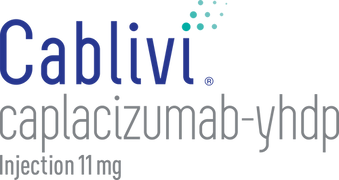Acquired thrombotic thrombocytopenic purpura (aTTP) is a rare, life-threatening blood disorder
aTTP is also known as immune-mediated thrombotic thrombocytopenic purpura (iTTP). aTTP and iTTP are the same condition. Your healthcare team may use either term.
The words that make up aTTP/iTTP help explain what is happening in the body
Acquired means you were not born with the condition. It is something you developed later in life. The main cause is not known. Immune-mediated means the cause of the condition is not known, but happens when the immune system isn’t working normally.
Thrombotic means blood clots form in the blood vessels. In aTTP/iTTP, small blood clots can form throughout the body.
Thrombocytopenic means having a lower number of blood platelets than you should. This happens because the platelets clump together to make blood clots throughout the body.
Purpura are purple bruises that are caused by bleeding under your skin. These bruises are a key symptom of aTTP/iTTP.
Even though aTTP/iTTP is a rare condition, you are not alone and CABLIVI, in combination with PEX and immunosuppression, can help.
Hear other people’s stories about CABLIVI >
CABLIVI is a breakthrough treatment for aTTP/iTTP designed to prevent blood clots
The first and only FDA-approved treatment that works with plasma exchange and immunosuppression to take on aTTP/iTTP in adults
Learn more about ISTH treatment guidelines and CABLIVI
CABLIVI, in combination with PEX and immunosuppression, can make a difference in your treatment.
See how >
You and your loved ones play an important role in your treatment
You play an important role in managing your own health. Talking with your doctor can help you get the most out of your aTTP/iTTP treatment. You can talk with them about anything, from what tests they’re doing to whether you are getting the aTTP/iTTP treatments that experts recommend. Talking to healthcare providers can feel scary or unsettling. If this is the case for you, you’re not the only one. Below are some tips to get you and your loved ones started.
Read more about how you can help someone with aTTP/iTTP >
Tips for talking with your care team about treatment options
-
Think about the questions you want to ask and write them down. Have your questions ready for the next time the doctor visits your room. It’s OK if you have new questions every day. It might help to keep a list in one place (like a planner or phone) so you can grab it whenever you talk with your care team
-
It’s OK to ask a question twice. Or 3 or 4 times! It’s better to keep asking until you understand than to leave the conversation still feeling confused
-
If possible, have a loved one in the room to help ask questions and hear your doctor’s answers. It can be hard to remember everything you want to ask or everything your doctor said. Having a loved one be a second set of ears can be helpful
-
Be your own best advocate by asking for all available treatment options, including CABLIVI. It might feel uncomfortable to ask, but just be honest. Tell them how you’re feeling and why you’re asking. You might want to start with something like, “I’m feeling scared and anxious, and I just want to make sure we’re doing everything possible to help get this under control”
-
Learn together. Remember that your care team might not be familiar with aTTP/iTTP because it’s so rare. You can ask if they have heard of CABLIVI or if they have seen the ISTH Guidelines and how those play into your treatment plan. You can also ask if they have any resources that will help you learn more about aTTP/iTTP and CABLIVI
Some questions you may want to ask when starting treatment
-
Can you walk me through my treatment plan? It would help if you could explain the different parts or steps
-
Am I an appropriate candidate for CABLIVI?
-
How will you know if my treatments are working?
aTTP/iTTP=acquired/immune-mediated thrombotic thrombocytopenic purpura; FDA=Food and Drug Administration; ISTH=International Society on Thrombosis and Haemostasis.
IMPORTANT SAFETY INFORMATION AND INDICATIONS
Who should not take CABLIVI?
Do not take CABLIVI if you’ve had an allergic reaction to caplacizumab-yhdp or to any of the ingredients in CABLIVI.
What should I tell my healthcare team before starting CABLIVI?
Tell your doctor if you have a medical condition including if you have a bleeding disorder. Tell your doctor about any medicines you take, including medicines that increase your risk of bleeding such as anti-coagulants and anti-platelet agents.
Talk to your doctor before scheduling any surgery, medical or dental procedure.
What are the possible side effects of CABLIVI?
CABLIVI can cause severe bleeding. In clinical studies, severe bleeding adverse reactions of nosebleed, bleeding from the gums, bleeding in the stomach or intestines, and bleeding from the uterus were each reported in 1% of subjects. In the post-marketing setting, cases of life-threatening and fatal bleeding were reported in patients receiving CABLIVI. Contact your doctor immediately if symptoms of excessive bruising, excessive bleeding, or major bleeding occur. Signs and symptoms of bleeding include: pain, swelling or discomfort, prolonged bleeding from cuts, increased menstrual flow or vaginal bleeding, nosebleeds, bleeding of gums from brushing, unusual bleeding or bruising, red or dark brown urine, red or tar black stools, headache, dizziness, or weakness.
You may have a higher risk of bleeding if you have a bleeding disorder (i.e. hemophilia) or if you take other medicines that increase your risk of bleeding such as anti-coagulants and anti-platelet agents.
CABLIVI should be stopped for 7 days before surgery or any medical or dental procedure. Talk to your doctor before you stop taking CABLIVI.
The most common side effects include nosebleed, headache and bleeding gums.
Tell your doctor if you have any side effect that bothers you or that does not go away. These are not all the possible side effects of CABLIVI. Call your doctor for medical advice about side effects.
What is CABLIVI?
CABLIVI (caplacizumab-yhdp) is a prescription medicine used for the treatment of adults with acquired thrombotic thrombocytopenic purpura (aTTP), in combination with plasma exchange and immunosuppressive therapy.
Please see full Prescribing Information.
Instructions For Use
Sharps Medical Waste Disposal (PDF)
Learn more about Sanofi’s commitment to fighting counterfeit drugs.
IMPORTANT SAFETY INFORMATION AND INDICATIONS
Who should not take CABLIVI?
Do not take CABLIVI if you’ve had an allergic reaction to caplacizumab-yhdp or to any of the ingredients in CABLIVI.
What should I tell my healthcare team before starting CABLIVI?
Tell your doctor if you have a medical condition including if you have a bleeding disorder. Tell your doctor about any medicines you take, including medicines that increase your risk of bleeding such as anti-coagulants and anti-platelet agents.
Talk to your doctor before scheduling any surgery, medical or dental procedure.
What are the possible side effects of CABLIVI?
CABLIVI can cause severe bleeding. In clinical studies, severe bleeding adverse reactions of nosebleed, bleeding from the gums, bleeding in the stomach or intestines, and bleeding from the uterus were each reported in 1% of subjects. In the post-marketing setting, cases of life-threatening and fatal bleeding were reported in patients receiving CABLIVI. Contact your doctor immediately if symptoms of excessive bruising, excessive bleeding, or major bleeding occur. Signs and symptoms of bleeding include: pain, swelling or discomfort, prolonged bleeding from cuts, increased menstrual flow or vaginal bleeding, nosebleeds, bleeding of gums from brushing, unusual bleeding or bruising, red or dark brown urine, red or tar black stools, headache, dizziness, or weakness.
You may have a higher risk of bleeding if you have a bleeding disorder (i.e. hemophilia) or if you take other medicines that increase your risk of bleeding such as anti-coagulants and anti-platelet agents.
CABLIVI should be stopped for 7 days before surgery or any medical or dental procedure. Talk to your doctor before you stop taking CABLIVI.
The most common side effects include nosebleed, headache and bleeding gums.
Tell your doctor if you have any side effect that bothers you or that does not go away. These are not all the possible side effects of CABLIVI. Call your doctor for medical advice about side effects.
What is CABLIVI?
CABLIVI (caplacizumab-yhdp) is a prescription medicine used for the treatment of adults with acquired thrombotic thrombocytopenic purpura (aTTP), in combination with plasma exchange and immunosuppressive therapy.
Please see full Prescribing Information.
Instructions For Use
Sharps Medical Waste Disposal (PDF)
Learn more about Sanofi’s commitment to fighting counterfeit drugs.
IMPORTANT SAFETY INFORMATION AND INDICATIONS
Who should not take CABLIVI?
Do not take CABLIVI if you’ve had an allergic reaction to caplacizumab-yhdp or to any of the ingredients in CABLIVI.
What should I tell my healthcare team before starting CABLIVI?
Tell your doctor if you have a medical condition including if you have a bleeding disorder. Tell your doctor about any medicines you take, including medicines that increase your risk of bleeding such as anti-coagulants and anti-platelet agents.
Talk to your doctor before scheduling any surgery, medical or dental procedure.
What are the possible side effects of CABLIVI?
CABLIVI can cause severe bleeding. In clinical studies, severe bleeding adverse reactions of nosebleed, bleeding from the gums, bleeding in the stomach or intestines, and bleeding from the uterus were each reported in 1% of subjects. In the post-marketing setting, cases of life-threatening and fatal bleeding were reported in patients receiving CABLIVI. Contact your doctor immediately if symptoms of excessive bruising, excessive bleeding, or major bleeding occur. Signs and symptoms of bleeding include: pain, swelling or discomfort, prolonged bleeding from cuts, increased menstrual flow or vaginal bleeding, nosebleeds, bleeding of gums from brushing, unusual bleeding or bruising, red or dark brown urine, red or tar black stools, headache, dizziness, or weakness.
You may have a higher risk of bleeding if you have a bleeding disorder (i.e. hemophilia) or if you take other medicines that increase your risk of bleeding such as anti-coagulants and anti-platelet agents.
CABLIVI should be stopped for 7 days before surgery or any medical or dental procedure. Talk to your doctor before you stop taking CABLIVI.
The most common side effects include nosebleed, headache and bleeding gums.
Tell your doctor if you have any side effect that bothers you or that does not go away. These are not all the possible side effects of CABLIVI. Call your doctor for medical advice about side effects.
What is CABLIVI?
CABLIVI (caplacizumab-yhdp) is a prescription medicine used for the treatment of adults with acquired thrombotic thrombocytopenic purpura (aTTP), in combination with plasma exchange and immunosuppressive therapy.
Please see full Prescribing Information.
Instructions For Use
Sharps Medical Waste Disposal (PDF)
Learn more about Sanofi’s commitment to fighting counterfeit drugs.




